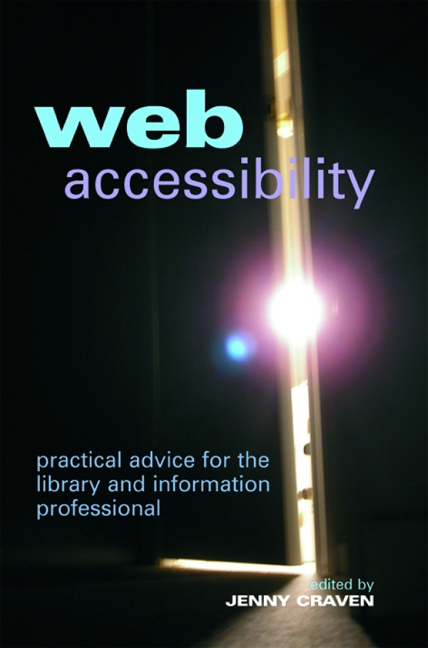Book contents
- Frontmatter
- Contents
- Contributors
- 1 Introduction
- 2 Tools used for widening access to the web
- 3 Design for All – how web accessibility affects different people
- 4 The importance of web accessibility
- 5 Accessibility advice and guidance
- 6 Accessibility evaluation and assessment
- 7 Issues for library and information services
- 8 Design for All in the library and information science curriculum
- 9 Best practice examples of web accessibility
- 10 Web accessibility in the future
- Index
9 - Best practice examples of web accessibility
Published online by Cambridge University Press: 08 June 2018
- Frontmatter
- Contents
- Contributors
- 1 Introduction
- 2 Tools used for widening access to the web
- 3 Design for All – how web accessibility affects different people
- 4 The importance of web accessibility
- 5 Accessibility advice and guidance
- 6 Accessibility evaluation and assessment
- 7 Issues for library and information services
- 8 Design for All in the library and information science curriculum
- 9 Best practice examples of web accessibility
- 10 Web accessibility in the future
- Index
Summary
Introduction
This chapter provides some examples of what is often referred to as ‘best practice’, the aim being to illustrate some of the areas relating to web accessibility covered elsewhere in this book with examples of good practice. The term ‘best practice’ can be defined as ‘a technique, method, process, activity, incentive or reward that is more effective at delivering a particular outcome than any other technique, method, process, etc.’ (Wikipedia, 2007). The term is also discussed in relation to developing approaches to finding and implementing best practice, where best practice is defined as ‘the best way of doing things in the sector (or [outside] the sector if useful examples can be found)’ (Brophy, 2006, 149).
The term should be treated with a little caution, however, as it can be open to interpretation and will depend on who is making the judgement that something is deemed to be ‘best practice’. For the purposes of this chapter, best practice will simply refer to examples of good working practices, initiatives and projects relating to web accessibility. It is not an exhaustive list, as evidence of best practice can sometimes be difficult to identify in literature or in library promotional material, perhaps because libraries are simply getting on with the job of providing an accessible and interesting website that will meet the needs of as many of their visitors as possible, but may not be actively promoting or reporting on it. Therefore, the examples provided here intend to demonstrate how web accessibility is being addressed through evidence of improving access to resources and to the overall experience; raising awareness of accessibility issues; studies undertaken to explore specific issues relating to web accessibility; and finally, activities and/or initiatives undertaken to improve and encourage access for all – including the importance of involving users in the process.
Enhancing the overall web experience
There is evidence of good work being undertaken not only to improve access to web resources, but also to enhance the overall experience. For example, Walsh (2006) describes some innovative ways in which visual content has been made accessible to visually impaired people. Examples include an online art exhibition presenting six works of art. Each work has a link to an audio description (which is presented as a speaker icon with alternative text).
Information
- Type
- Chapter
- Information
- Web AccessibilityPractical Advice for the Library and Information Professional, pp. 127 - 144Publisher: FacetPrint publication year: 2008
